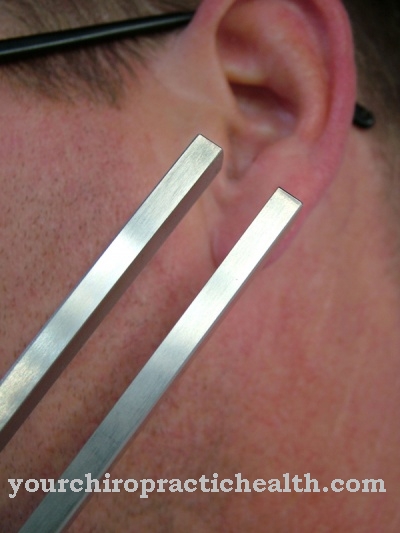In the Scintigraphy (also: scintigraphy) is an imaging process in medicine. With the help of the injection of low-level radioactive substances and a gamma camera, certain tissue structures can be made visible.
What is scintigraphy?

The Scintigraphy belongs to the field of nuclear medicine, in which medical professionals make use of the properties of radioactive substances - for example, to be able to examine organs or other tissues within the human body without surgery.
To do this, the examiner injects a drug that is radioactive: a so-called radiopharmaceutical. Since different types of tissue require different nutrients, different substances are also used and radioactively marked for radiopharmaceuticals - depending on which tissue is to be examined. A gamma camera measures the radioactive radiation emanating from the marker and can thus make the corresponding tissue visible.
A distinction can be made between two types of scintigraphy: Functional scintigraphy depicts the activity of the tissue, while static scintigraphy primarily depicts structures without taking into account the processes taking place in them.
Function, effect & goals
The radiopharmaceuticals used in the Scintigraphy If they are used, they accumulate to different degrees in the tissue: tissue whose metabolism is very active is supplied by the organism with a corresponding number of nutrients and thus also absorbs the radioactive marker to a greater extent.
That is why scintigraphy is mainly used to detect tumors; because a tumor is such a tissue that has an increased metabolism. Metastases, cysts or inflammation can also be detected using the same principle: The higher concentration of the marker leads to increased radioactive radiation in this area - which ultimately appears on an image (the scintigram) mostly as red or yellow areas.
Deformations and other anomalies are also revealed in the scintigram. In addition, the scintigraphy shows whether vessels are blocked or certain tissue is undersupplied. Such conditions are noticeable in the resulting image in that the corresponding areas are less colored than would be expected from healthy tissue.
Both static and functional scintigraphy are suitable for these applications. As a rule, however, the recording of a static image is sufficient. In principle, scintigraphy can be used on all organs. However, due to their location in the body and their metabolic processes, the lungs, thyroid gland, heart and kidneys in particular are predestined for an examination with this method. In addition, scintigraphy is often used to examine the skeleton or individual bones. Bruises can already be recognized here - even if no external injury is visible.
Scintigraphy is mainly used in the clinical and medical field and less often in research with healthy subjects. This is mainly because the suspicion of a serious illness justifies the use of (potentially harmful) radioactive substances and this is also in the interests of the patient; other methods that are less invasive tend to be used for research purposes only. Like all medical examinations, scintigraphy requires a cost-benefit analysis.
Risks & dangers
Although the Scintigraphy radioactive materials are used, it is considered to be largely risk-free. Only pregnant women should not be examined with this method, since even low radiation concentrations can be risky for an unborn child.
For the same reason, the recommendation applies not to stay in the immediate vicinity of pregnant women after a scintigraphy, as long as the radiation has not subsided. However, this is often the case after a day or two. Caution is also advised in breastfeeding women, children and adolescents. That is why members of this group of people are only examined using scintigraphy in well-founded exceptional cases.
Nevertheless: The dose of radioactive radiation with scintigraphy is not higher than with comparable procedures, for example X-rays - and even significantly lower than with computer tomography. Before the examination, patients are also given the opportunity to ask questions and express their concerns in an informative discussion.



























